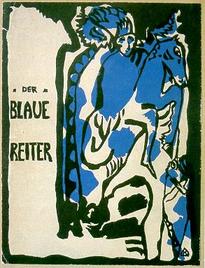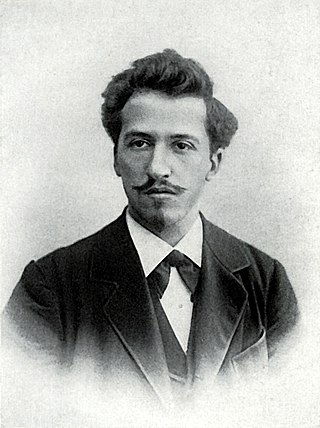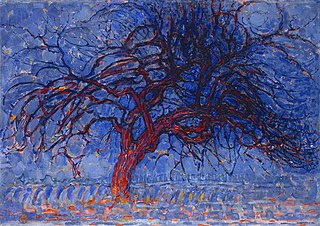
Wassily Wassilyevich Kandinsky was a Russian painter and art theorist. Kandinsky is generally credited as one of the pioneers of abstraction in western art. Born in Moscow, he spent his childhood in Odesa, where he graduated from Odesa Art School. He enrolled at the University of Moscow, studying law and economics. Successful in his profession—he was offered a professorship at the University of Dorpat —Kandinsky began painting studies at the age of 30.

Abstract art uses visual language of shape, form, color and line to create a composition which may exist with a degree of independence from visual references in the world.

Der Blaue Reiter is a designation by Wassily Kandinsky and Franz Marc for their exhibition and publication activities, in which both artists acted as sole editors in the almanac of the same name, first published in mid-May 1912. The editorial team organized two exhibitions in Munich in 1911 and 1912 to demonstrate their art-theoretical ideas based on the works of art exhibited. Traveling exhibitions in German and other European cities followed. The Blue Rider disbanded at the start of World War I in 1914.

The Kunstmuseum Den Haag is an art museum in The Hague in the Netherlands, founded in 1866 as the Museum voor Moderne Kunst. Later, until 1998, it was known as Haags Gemeentemuseum, and until the end of September 2019 as Gemeentemuseum Den Haag. It has a collection of around 165,000 works, over many different forms of art. In particular, the Kunstmuseum is renowned for its large Mondrian collection, the largest in the world. Mondrian's last work, Victory Boogie-Woogie, is on display at the museum.

Victory Boogie Woogie is the last, unfinished work of the Dutch abstract painter Piet Mondrian, left incomplete when Mondrian died in New York in 1944. He was still working on it three days before dying. Since 1998 it has been in the collection of the Kunstmuseum, in The Hague. It has been said that "Mondrian's life and his affection for music are mirrored in the painting [and that it is] a testimony of the influence which New York had on Mondrian."

Hilma af Klint was a Swedish artist and mystic whose paintings are considered among the first abstract works known in Western art history. A considerable body of her work predates the first purely abstract compositions by Kandinsky, Malevich and Mondrian. She belonged to a group called "The Five", comprising a circle of women inspired by Theosophy, who shared a belief in the importance of trying to contact the so-called "High Masters"—often by way of séances. Her paintings, which sometimes resemble diagrams, were a visual representation of complex spiritual ideas.

Pieter Cornelis Mondriaan, after 1906 known as Piet Mondrian, was a Dutch painter and art theoretician who is regarded as one of the greatest artists of the 20th century. He is known for being one of the pioneers of 20th-century abstract art, as he changed his artistic direction from figurative painting to an increasingly abstract style, until he reached a point where his artistic vocabulary was reduced to simple geometric elements.

Maude Irvine Kerns was an American artist and art educator, known for her avant-garde paintings. Her works were exhibited at the Guggenheim Museum, National Gallery of Art, and the Salon des Réalités Nouvelles, and earned Kerns considerable notoriety among the abstract art movement in New York. She later taught art at the University of Oregon as well as at high schools in Corvallis and Seattle, Washington before her death in 1965.

The Yellow Sound is an experimental theater piece originated by the Russian artist Wassily Kandinsky. Created in 1909, the work was first published in The Blue Rider Almanac in 1912.
Linien was an artists' association in Denmark in the 1930s and 1940s focusing on Abstraction and Symbolism. The group's exhibitions in Copenhagen created wide international participation. After the Second World War, the association was revived as Linien II with an emphasis on Concrete art.

Composition VII is an abstract oil painting executed in 1913 by Wassily Kandinsky, a Russian-born painter. It is in the collection of the Tretyakov Gallery, in Moscow. Art historians have concluded that the work is a combination of the themes of Resurrection, Judgment Day, the Flood and the Garden of Eden.

Evening; Red Tree is a 1908–1910 oil on canvas painting by the Dutch artist Piet Mondrian in the Gemeentemuseum Den Haag.

Laxmi Prasad Sihare was an Indian civil service officer, curator, art writer and the director-general of the National Gallery of Modern Art (NGMA). It was during his directorship, an art exhibition on Auguste Rodin was organized by the museum.

Caoutchouc is a painting created circa 1909 by the French artist Francis Picabia. At the crossroads of Cubism and Fauvism, Caoutchouc is considered one of the first abstract works in Western painting. The painting is in the collection of Centre Pompidou, Musée National d'Art Moderne, in Paris.

Upward is an oil on cardboard painting created in 1929 by the Russian abstract painter Wassily Kandinsky. Painted at a time when Kandinsky was teaching art at the Bauhaus in Dessau, Germany, it now forms part of the Peggy Guggenheim Collection in the Palazzo Venier dei Leoni, Venice, Italy.

The Red Cloud is an 1907 early painting by the Dutch artist Piet Mondrian. It was painted in 1907. Mondrian completed the painting while staying near Oele, in the east of the Netherlands. One art historian has noted that the "hard colour contrasts and charged, expressive brushwork" is part of Mondrian's evolution towards an abstract painter.

Evolution is an early painting by the Dutch artist Piet Mondrian. It was executed in 1911, after the artist had visited Paris. The painting represents a mid-point in Mondrian's journey from realistic landscapes to radical abstraction. Symbolic in form and with stylised lines, it was Mondrian's last painting where he painted a human form. Soon after Mondrian completed the painting, it was exhibited as part of the first Moderne Kunstring exhibition at the Stedlijk Museum in Amsterdam.

Composition with Yellow Lines is an 1933 abstract painting on canvas by Dutch artist Piet Mondrian. While following the grid like structures of his other abstract paintings, it is unusual in omitting the use of any black lines. Indeed, Mondrian's earlier writings on art had stated that any lines in his paintings had to be black; colour was reserved for the filled in rectangles. The painting is equally unusual in that none of the lines meet. He did not paint any further paintings with this design element until his move to New York in 1940.

A Farmhouse Behind A Fence is a 1904 painting by the Dutch artist Piet Mondrian. It was completed early in his career, in 1904, when "the artist abruptly broke from his former life and went into rural seclusion in Brabant, a province in southern Netherlands." He painted numerous canvases on a rural theme: "in his initial public appearances as a professional artist Mondrian was more concerned with supplying a product that would sell than defining his own personal style."

















